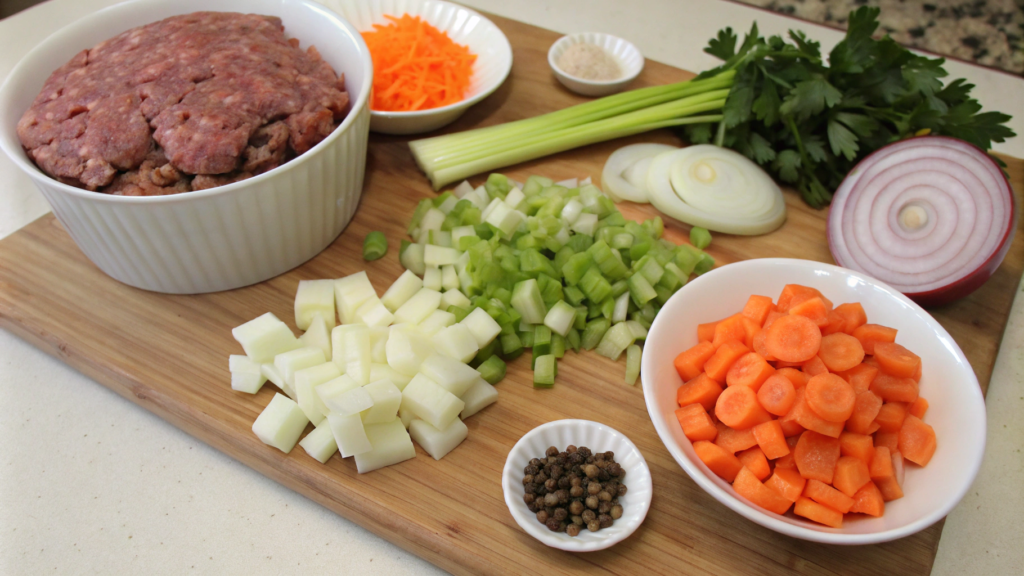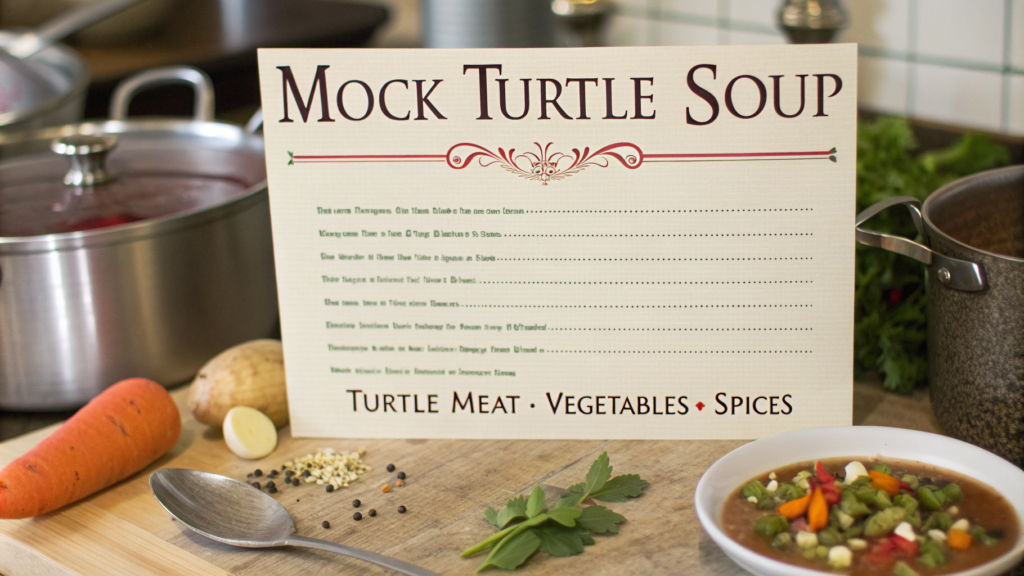The Rich Legacy and Modern Appeal of Mock Turtle Soup

Table of contents
There’s something magical about mock turtle soup. It’s more than just a dish; it’s a slice of history and a testament to culinary creativity. This old-timey favorite brings together unique ingredients and techniques, creating a flavor that feels nostalgic yet contemporary. In this article, we’ll explore its fascinating origins, break down its key components, and even dive into step-by-step instructions for making it yourself. Along the way, we’ll uncover its place in literature, nutritional insights, and some commonly asked questions. Whether you’re a soup enthusiast or simply curious, you’re in for a flavorful journey.
The Origins and History of Mock Turtle Soup
What is Mock Turtle Soup?
it’s an imitation of the once-popular turtle soup, a delicacy in the 18th and 19th centuries. Back then, real turtle meat was a prized ingredient. However, not everyone could afford it, so ingenious cooks created a version using simpler, more accessible ingredients. Instead of turtle, they used ground beef or veal to mimic the texture and richness of the original.
“For more details about the fascinating history of mock turtle soup, check out The History of Mock Turtle Soup by WIKIPEDIA. It’s a deep dive into how this dish became so iconic.”
The word “mock” means imitation, and this dish embodies that idea beautifully. Despite the absence of turtle, the soup retains a hearty, savory profile that satisfies any palate. Over the years, this humble creation became a household staple, especially in Britain and the United States. Its versatility and flavor made it popular among families looking for comfort food.
Also, mock turtle soup isn’t just food—it’s a conversation starter. Its quirky name has sparked curiosity for centuries, inviting people to explore its origins and significance. When you serve this soup, you’re sharing a piece of culinary history.
Mock Turtle Soup in 18th and 19th Century Britain
During the 18th century, turtle soup was synonymous with luxury. Served at high-society banquets, it symbolized wealth and sophistication. But for those who couldn’t afford turtles, cooks devised a clever alternative: mock turtle soup. This creative solution wasn’t just cost-effective; it also reflected a resourceful approach to cooking.
In Victorian Britain, this soup gained a foothold as a comforting, everyday dish. The ingredients—ground meat, vegetables, and spices—were easy to find. Adding items like gingersnaps and sherry gave the soup a rich, complex flavor. Over time, recipes evolved, with each cook adding personal touches to make it their own.
Today, mock turtle soup carries the legacy of those inventive cooks. It’s a reminder of how people adapted recipes to fit their lives while keeping traditions alive. This adaptability is part of what makes the dish timeless.
Evolution of the Recipe: From Authenticity to Convenience
Originally, mock turtle soup closely mimicked the texture and taste of real turtle soup. Cooks used veal heads, which provided gelatin and a chewy consistency similar to turtle meat. However, as culinary trends shifted, recipes simplified. Ground beef became the go-to ingredient, offering a quicker, easier way to make the dish without sacrificing flavor.
In addition, modern adaptations include turkey, vegetarian options, and gluten-free versions. While the ingredients may vary, the essence of mock turtle soup—its heartiness and layered flavors—remains the same. Even today, it’s a comforting bowl that bridges the gap between tradition and innovation.
Key Ingredients in Mock Turtle Soup

Primary Components: The Role of Ground Meat and Gingersnaps
At the heart of mock turtle soup lies the clever substitution of ground meat for turtle. Traditionally, cooks used veal or beef to recreate the rich, hearty texture of turtle meat. Ground beef became the most popular option because it’s easy to find and affordable. It also cooks quickly, making it perfect for busy families. Next, gingersnaps may sound unusual, but they’re a game-changer. They thicken the soup while adding a warm, slightly sweet flavor. This unique ingredient gives the dish a distinct personality.
In addition to ground meat and gingersnaps, the soup often includes hard-boiled eggs. Chopped finely, these add a creamy texture that balances the sweetness of the gingersnaps. Together, these ingredients create a symphony of flavors. They’re simple on their own but magical when combined. These classic components make mock turtle soup comforting and delicious, perfect for any occasion.
Enhancing Flavors with Classic Seasonings
Seasonings play a big role in making mock turtle soup unforgettable. Worcestershire sauce, for instance, adds depth and a hint of tanginess. It’s a little salty, a little savory, and absolutely essential. Next, lemon slices bring a bright, citrusy kick. This touch of acidity cuts through the soup’s richness, making every bite balanced and refreshing.
“If you’re curious about enhancing flavors in traditional recipes, you might also enjoy learning How to Make Venison Taste Like Beef. It’s all about using the right techniques to bring out the best in your ingredients.”
Then there’s sherry wine. This small addition ties all the flavors together beautifully. It provides a subtle sweetness and elevates the overall taste. Black pepper adds just the right amount of spice, while onions bring in a savory base. Layering these seasonings creates a soup that’s more than the sum of its parts.
With each spoonful, you taste the careful balance of sweet, savory, and tangy flavors. These seasonings show how a few simple ingredients can make a huge difference. The result is a bowl of mock turtle soup that feels both old-fashioned and timeless.
Optional Variations and Modern Twists
Over the years, mock turtle soup has adapted to suit modern tastes and dietary needs. First, many cooks replace ground beef with turkey for a leaner version. It’s just as hearty but with fewer calories. For vegetarians, lentils or mushrooms make great alternatives. They mimic the texture of meat while keeping the soup satisfying.
Some cooks also experiment with flavors. Adding curry powder or chili flakes gives the soup a spicy twist. For a smoky depth, a dash of paprika works wonders. Gluten-free gingersnaps ensure everyone can enjoy the dish. It’s easy to tweak the recipe to match your preferences.
Even with these changes, the soup’s essence stays the same. It’s hearty, comforting, and full of flavor. Modern twists breathe new life into this classic dish, making it accessible to everyone. With these variations, mock turtle soup continues to charm kitchens worldwide.
How to Make Mock Turtle Soup: A Step-by-Step Guide

Preparation and Ingredients List
To make mock turtle soup, you’ll need a handful of simple ingredients. Ground beef is the star, providing that rich, hearty base. Gingersnaps are next—they thicken the soup and add a unique sweetness. Then, you’ll need Worcestershire sauce, lemon slices, onions, and hard-boiled eggs. These all contribute to the soup’s layered flavors. Sherry wine is optional but highly recommended for a sophisticated touch.
Start by gathering all your ingredients. It’s always helpful to have everything ready before you cook. Chop the onions finely, and crush the gingersnaps in a bowl. Next, hard-boil the eggs and set them aside to cool. With your prep done, you’re ready to cook.
Having a good prep setup makes the process smoother. It’s like putting together puzzle pieces—each ingredient adds something special to the dish. Soon, your mock turtle soup will come to life!
Cooking Techniques for Layered Flavors
Cooking mock turtle soup is straightforward but requires attention to detail. First, brown the ground beef in a large pot. This step develops a deep, savory flavor. While the beef cooks, soak your crushed gingersnaps in warm water. This creates a paste that will thicken the soup later.
Next, add the finely chopped onions to the pot. Cook until they’re soft and fragrant. Pour in Worcestershire sauce and water to create the soup base. Stir well to combine. Then, add the gingersnap paste, lemon slices, and seasonings. Let everything simmer gently for an hour, stirring occasionally.
Toward the end, add the chopped hard-boiled eggs and a splash of sherry. This final touch elevates the soup’s flavor. Once done, remove the lemon slices and give it a taste. Adjust the seasoning as needed. Your mock turtle soup is now ready to serve!
Tips for Perfecting the Recipe
Getting mock turtle soup just right takes a little practice. First, don’t rush the simmering process. Letting the soup cook slowly allows the flavors to blend beautifully. Also, taste as you go. It’s easier to add more seasoning than to fix an overly salty soup.
Next, balance is key. If the soup tastes too sweet from the gingersnaps, add a splash of vinegar or lemon juice. This simple trick brightens the flavors. If it’s too thick, stir in a little water to reach your desired consistency.
Presentation matters too! Garnish with fresh herbs like parsley for a pop of color. A warm bowl of mock turtle soup looks and tastes irresistible. With these tips, you’ll impress anyone lucky enough to try your creation!
Cultural Resonance and Literary Connections
Mock Turtle Soup in Literature
Mock turtle soup has left its mark not just in kitchens but also in literature. One famous example comes from Lewis Carroll’s Alice’s Adventures in Wonderland. In this whimsical story, the Mock Turtle is a character who humorously explains how he got his name. The tale highlights the dish’s popularity during Carroll’s time, as audiences would instantly understand the joke.
This literary nod also reflects the soup’s quirky appeal. It wasn’t just food—it was a cultural phenomenon. Victorian readers loved Carroll’s playful twist on the dish’s name, and it added charm to the story. The Mock Turtle character even sings about the soup, blending absurdity and nostalgia.
Today, the reference keeps the dish alive in popular culture. It reminds us of a time when mock turtle soup was both practical and symbolic. It’s a delightful example of how food and storytelling connect.
A Culinary Reflection of History and Society
Mock turtle soup tells a story of resourcefulness. When turtle meat became scarce or too expensive, people didn’t give up on their favorite dish. Instead, they found creative ways to replicate its flavor and texture. This adaptability speaks to the human spirit and the power of culinary invention.
The soup also reflects the values of its time. In the 18th and 19th centuries, people celebrated both thrift and indulgence. By using simple ingredients to recreate a luxury item, mock turtle soup bridged the gap between practicality and aspiration. It was a way for families to enjoy a touch of elegance without breaking the bank.
Even today, the dish carries that sense of ingenuity. It shows how food adapts to changing times while preserving tradition. When you make mock turtle soup, you’re participating in a history that spans centuries. It’s a comforting reminder of the creativity and warmth found in home cooking.
Nutritional Insights and Dietary Considerations
Health Benefits and Drawbacks of Key Ingredients
The ingredients in mock turtle soup offer a mix of benefits and potential concerns. Ground beef, for example, provides protein and iron. These nutrients support energy levels and overall health. However, high-fat cuts can add calories, so choosing lean beef is a smart move.
Next, gingersnaps may surprise you with their role. They not only thicken the soup but also add antioxidants from the spices, like ginger and cinnamon. However, they’re also sweetened, so moderation is key. Worcestershire sauce brings depth of flavor while adding small amounts of sodium.
Hard-boiled eggs contribute protein and healthy fats, enhancing the soup’s richness. Sherry wine, though optional, adds a touch of sophistication. Overall, mock turtle soup can be a hearty and nutritious meal when balanced with thoughtful ingredient choices.
Adapting the Recipe for Modern Lifestyles
Making mock turtle soup work for today’s dietary needs is easy. For a lower-fat option, swap ground beef for ground turkey. It keeps the soup hearty without adding extra calories. Vegetarians can replace meat with lentils or mushrooms, which offer texture and flavor.
Gluten-free versions are simple, too. Substitute gluten-free gingersnaps and ensure other ingredients are safe for those with sensitivities. If you’re watching your sodium, reduce the Worcestershire sauce and choose low-salt broth.
Adding more vegetables, like carrots or celery, boosts the nutritional value. These tweaks make the soup adaptable for almost anyone. Whether you need a lighter version or want to try something new, mock turtle soup can fit into any diet. It’s a dish that welcomes creativity while keeping its traditional charm.
Frequently Asked Questions
Is Mock Turtle Soup Made with Turtles?
Despite its name, mock turtle soup doesn’t include any turtles! The word “mock” means it imitates the original dish. Traditional turtle soup, once made with green sea turtles, inspired this creative version. Today, ground meat, often beef or veal, substitutes for turtle meat. This change makes the dish more accessible and sustainable.
People often wonder if the name creates confusion. Historically, it might have, but now it’s just a fun talking point. The quirky name adds charm to the dish’s long history. You can think of it as a playful nod to its origins.
So, when serving this dish, you can confidently share its history. It’s an imitation that feels just as special as the real thing. This makes mock turtle soup perfect for anyone curious about its roots or eager to try something new.
What Are the Best Substitutes for Traditional Ingredients?
You can easily adapt mock turtle soup by swapping ingredients. For a leaner option, try ground turkey instead of beef. This reduces the fat content while keeping the hearty texture. Vegetarian substitutes, like lentils or mushrooms, work just as well. These add protein and mimic the chewiness of meat.
For a gluten-free version, replace gingersnaps with gluten-free cookies or crushed crackers. You can also adjust the seasonings to suit your taste. Some people add paprika for a smoky flavor, while others like a dash of chili for heat.
The beauty of this dish is its flexibility. You don’t need to follow the original recipe exactly. Instead, you can create a version that fits your dietary needs. No matter how you tweak it, the essence of mock turtle soup stays delicious and comforting.
How Can I Serve Mock Turtle Soup?
Mock turtle soup shines on its own, but you can elevate it with thoughtful pairings. Serve it with crusty bread for dipping. The soup’s rich, savory flavors balance perfectly with warm, buttery bread. Adding a crisp salad brings freshness to the meal. Greens with a light vinaigrette can cut through the soup’s richness.
“For a hearty pairing, consider serving your mock turtle soup alongside a perfectly roasted dish like our Perfect Venison Roast Recipe. The combination of flavors will elevate your meal to the next level.“
If you’re hosting, consider garnishing the soup. Sprinkle fresh parsley on top for a pop of color. A lemon wedge on the side adds a citrusy kick for those who enjoy brighter flavors. Serving in a warm bowl also enhances the experience.
For drinks, pair the soup with sherry or a light red wine. This complements the flavors without overpowering them. Whether it’s a casual dinner or a special occasion, mock turtle soup adapts beautifully to any table setting.
Conclusion
Mock turtle soup is more than a recipe—it’s a story of creativity, history, and heartwarming flavor. From its quirky name to its rich ingredients, it’s a dish that has charmed generations. Whether you’re recreating a traditional version or adding your own modern twists, the soup never fails to impress.
Its layered flavors and comforting texture make it a favorite for family dinners or special gatherings. It’s adaptable, too, so you can tweak it to fit your tastes or dietary needs. Plus, it’s a fun way to connect with culinary history. Sharing a bowl feels like sharing a piece of the past.
If you’ve never tried making mock turtle soup, now’s the time. You’re not just cooking—you’re keeping a tradition alive. Grab your ingredients, put on your apron, and dive into this delightful, time-tested dish. You’ll be glad you did!
